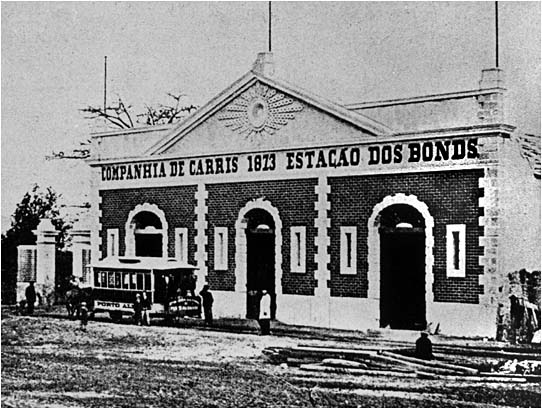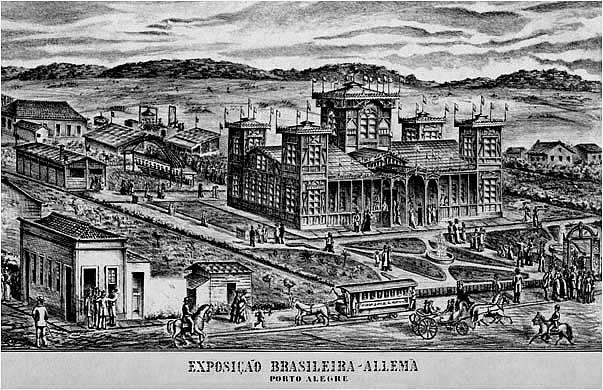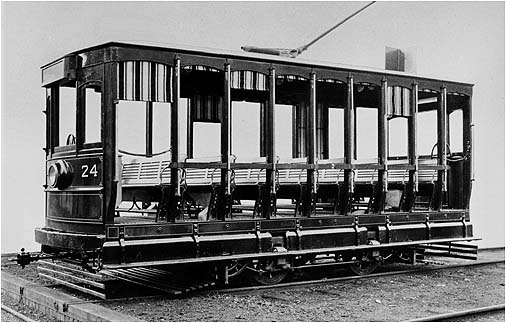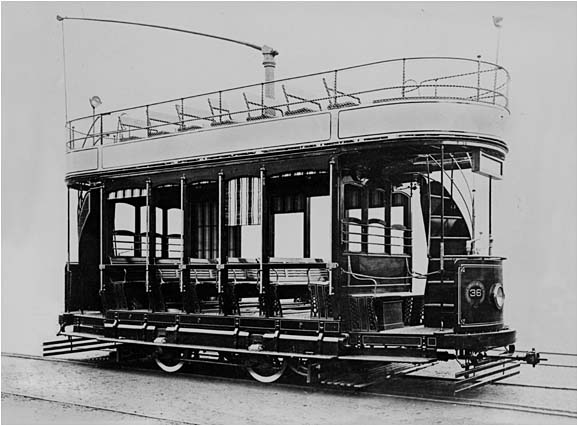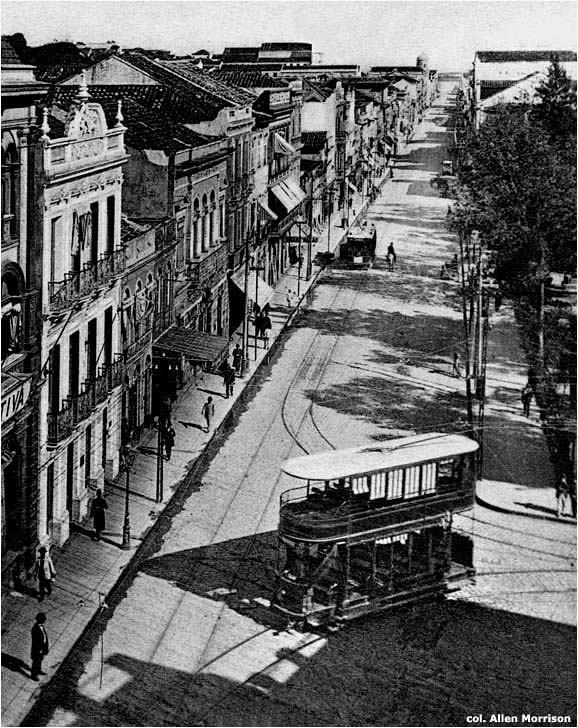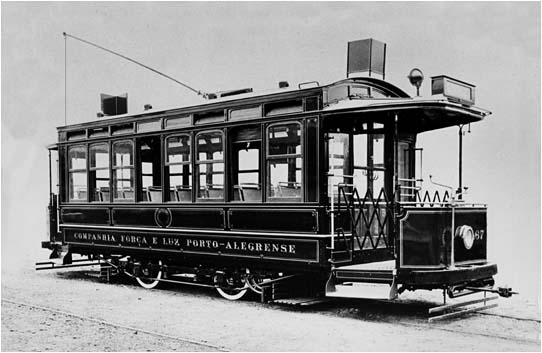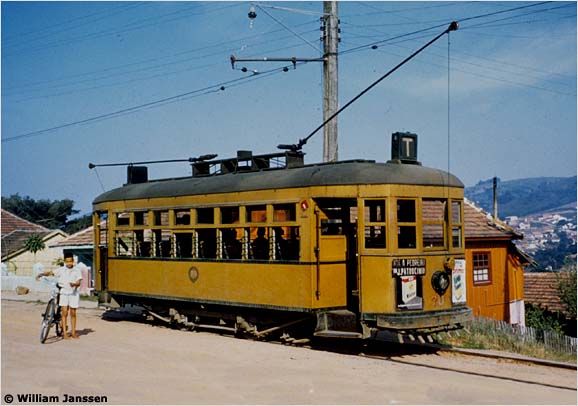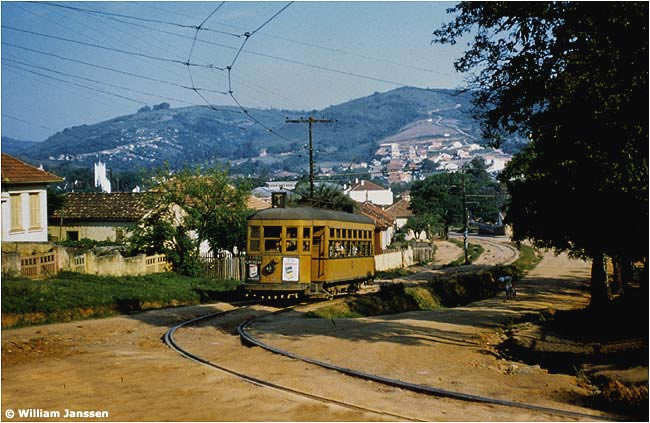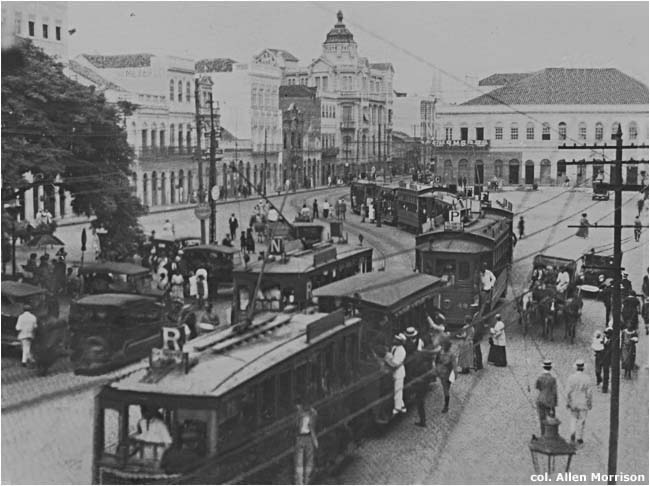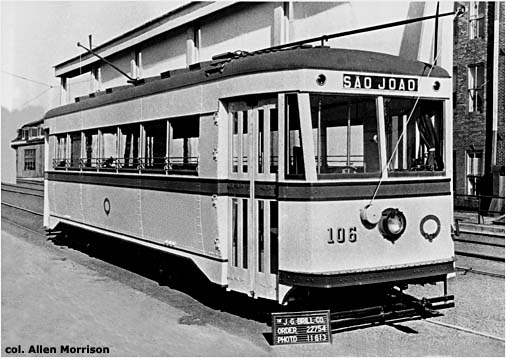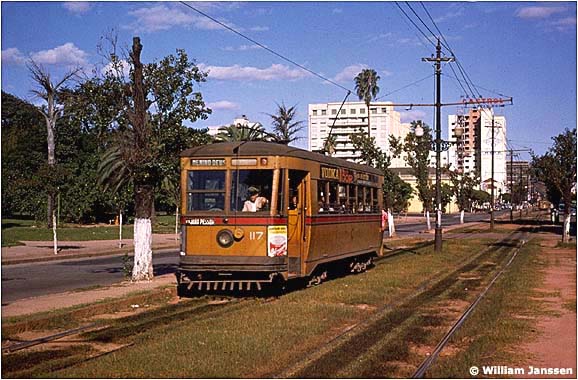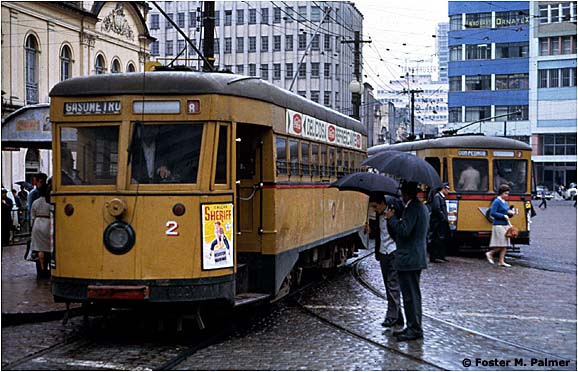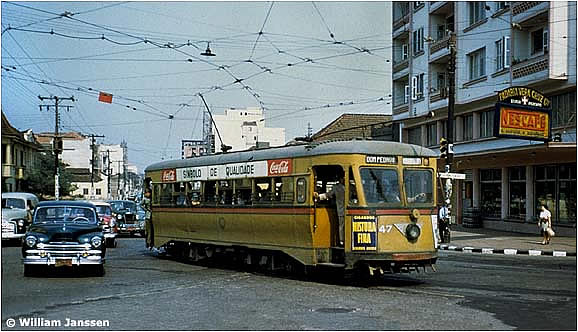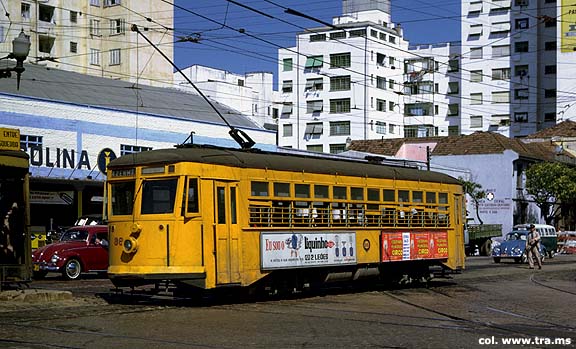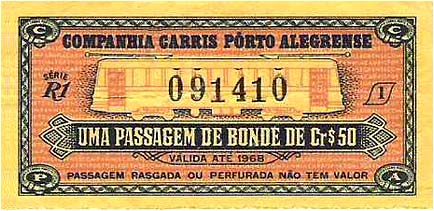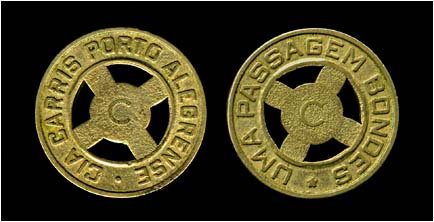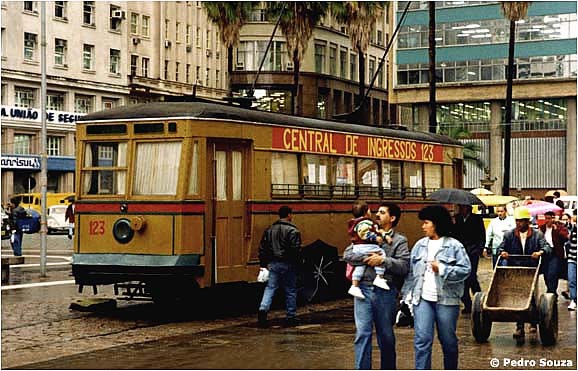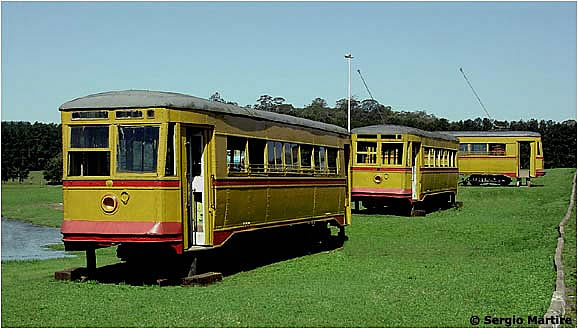The Tramways of PORTO ALEGRE Rio Grande do Sul state BRAZIL BY Allen Morrison [Veja versão em português] Rio Grande do Sul is the southernmost state in Brazil and is about the size (and shape) of Poland. Its capital, Porto Alegre, is on the Rio Guaíba at the north end of Lagoa dos Patos, a huge inland bay about 200 km long and 60 km wide. The city's population was 100,000 in 1900 and is 3 million today. Porto Alegre was always a thriving port and two local businessmen, a Brazilian named Estácio da Cunha Bittencourt and a Frenchman named Emílio Gembembre, opened a horsecar line between the waterfront and Menino Deus on 1 November 1864 [see map]. This was the second street railway in Brazil, preceded only by the Tijuca line in Rio de Janeiro, which opened in 1859. The vehicles were said to be double-deckers, but nothing is known of their origin and no pictures of them have been found. Operation ended in early 1872. A new company, Carris de Ferro Porto-Alegrense, formed on 19 June 1872, acquired new trams from John Stephenson in New York, laid new meter-gauge rails along the same route, and opened a new tramway on 4 January 1873. CFPA's depot was on Av. João Pessoa [see map] [col. Biblioteca Municipal, Porto Alegre]:
The lithograph below shows a tram passing a German trade fair in 1881 [col. Metropolitan Museum of Art, New York]:
A third company, Carris Urbanos de Porto Alegre, laid standard 1435 mm gauge tracks and opened new tram routes in other parts of the city during the 1880s. This postcard shows both a standard-gauge tram (left) and meter-gauge trams (right) on Rua dos Andradas about 1900 [see map] [col. AM]:
On 24 January 1906 the CFPA and CUPA merged and formed the new Companhia Força e Luz Porto-Alegrense, which thereafter operated all tramways and electric utilities in the city. CFLPA began electrification of the tramway system, established standard 1435 mm gauge and, on 22 August 1906, ordered 37 electric trams from United Electric Co. in Preston, England. (United Electric was renamed English Electric in 1918 and was associated with Dick, Kerr & Co.) The photograph below, taken in England before it left for Brazil, shows one of the 35 small 8-bench cars, which were numbered 1-35 [col. AM]:
Trams 36 and 37 were double-deckers, with 8 benches on the first floor and 7 more rows of seats on the roof. This picture of 36 was taken in England [col. AM]:
Double-deckers 36 and 37 inaugurated the electric tramway in Porto Alegre on 10 March 1908. The postcard view below shows the same corner on Rua dos Andradas as the third image above, but after electrification [see map]. The upper deck of the double-decker has been covered. A single-deck car approaches in the distance [col. AM]:
This postcard shows one of the single-deck trams on Rua Voluntários da Pátria [col. AM]:
Between 1909 and 1920 United Electric sent CFLPA two more double-deck cars, numbered 38-39, eight more small open cars, numbered 40-47, and forty larger closed cars, numbered 48-87. Here is a builder's photo of tram 67 of the latter group [col. AM]:
In the 1920s the open cars were rebuilt closed and the four double-deckers were reduced to single deck. Tram 70 below, photographed in 1957, is from the United Electric 48-87 series shown in tram 67 above. "T" identifies the TERESÓPOLIS line [see map] [William Janssen]:
Here is another view of United Electric 70 on the TERESÓPOLIS line [see map] in 1957 [William Janssen]:
In 1925 CFLPA ordered ten closed trams from Ateliers de Construction Energie in Marcinelle, Belgium: five single-truck cars, numbered 88-92, and five double-truck cars, numbered 101-105. The undated photograph below may show some of these vehicles. Note left-hand operation – English style – of both trams and automobiles [col. AM]:
The Brazilian government dissolved CFLPA in 1926 and formed separate companies for transportation and utilities: the new operator of the streetcars was Companhia Carris Porto-Alegrense. CCPA was acquired two years later by the U.S. conglomerate, Electric Bond & Share, which initiated an import program that would make Porto Alegre a mecca for North American tramway enthusiasts in the 1950s and 1960s. On 31 December 1928 the new CCPA/EBS ordered 20 double-truck cars from J. G. Brill in Philadelphia, which were numbered 106-125 in Porto Alegre [col. AM]:
Brill tram 117 of his series had been altered slightly by the time it was photographed on Av. João Pessoa in 1957. The destination box reads MENINO DEUS [see map] [William Janssen]:
In 1929 CCPA purchased 32 "Birney" trams second-hand from Baltimore, which it numbered 126-157, and eight cars of the same type from Eastern Massachusetts Street Railway near Boston, which it numbered 158-165. All had been built by Brill in the early 1920s. In 1933 CCPA constructed 10 "Birney" cars of its own, which it called Millers (after a CCPA engineer) and numbered 166-175. And in 1934 it acquired 20 trams second-hand from Richmond Railways on Staten Island in New York City, which had been built by Osgood-Bradley in Massachusetts in the 1920s. They were extensively rebuilt in Porto Alegre and numbered in new series 1-20 [Foster M. Palmer]:
This 1957 photograph shows Staten Island car 12 with dramatically different colors. This tram is signed for AUXILIADORA [see map] [William Janssen]:
In 1936 CCPA purchased 20 more trams from Eastern Massachusetts Street Railway – large 4-axle cars built in 1923 by Kuhlman – which it numbered 21-40. In 1937 it spliced 14 of its Baltimore Birneys together and built seven double-truck curved-side cars which it nicknamed "Texanos" (after their Texan designer) and numbered 41-47. Number 47 is signed DOM PEDRO II [see map] [Willliam Janssen]:
The year 1940 brought four large trams from York, Pennsylvania. Three "Master-Unit" cars built by Brill were numbered 176-178 and later 101-103; an "Electromobile" built by Osgood-Bradley was numbered 179, later 100. Brill car 102 ex-177 was photographed on Av. Protásio Alves, near the end of the PETRÓPOLIS line [see map], in January 1957 [William Janssen]:
1940 also brought a dozen 12-window trams that Perley Thomas Car Works in High Point, North Carolina, built for Miami in 1925. They were numbered 180-191 in Porto Alegre, later renumbered 88-99. Here is ex-Miami tram 98, signed AZENHA [see map], in 1968 [col. www.tra.ms]:
Finally, 25 double-truck cars built by Osgood-Bradley in 1927 for the Worcester Street Railway in Massachusetts were sent to Porto Alegre in 1946. Their new Porto Alegre numbers were 126-150. Ex-Worcester tram 137 was photographed in 1957 [William Janssen]:
The 130 American cars, 89 English cars and 10 Belgian cars made Porto Alegre seem like the largest operating tramway museum in the world. Here is a CCPA ticket – "good until 1968":
and a CCPA token [col. AM]:
The Americans returned transit operation to the city on 19 February 1954. The new Departamento Autônomo de Transportes Coletivos reported that 89 million passengers were carried by 105 trams in 1961. DATC decided to replace the rail cars with buses and inaugurated a trolleybus line on 7 December 1963: five Massari units ran to Gasômetro and Menino Deus – along the streets where mulecars had originated tramway service 102 years before. The trolleybus line closed in 1969 and DATC ran the last tram in Porto Alegre on 8 March 1970. Except for Santos in 1971, this was the last large tram system in Brazil to close. Most of the tram fleet was scrapped but DATC saved Texano number 46 and several Brill cars, including 113 and 123. Number 113, which was the last to operate in 1970, is now at the Museu Joaquim José Felizardo on Rua João Alfredo. Number 123 is presently the reception office at Carris headquarters on Rua Albion, but during the 1990s it was displayed on Praça XV de Novembro [see map]. The photograph below was taken in July 1994. A section of track remained, but the overhead wire was long gone [Pedro Souza]:
The picture below of two unidentified Brill cars and Texano 46 was taken in October 2006 at a park near Gravataí, 30 km east of Porto Alegre [Sergio Martire]:
Plans for a heritage tramway have been announced several times since the tramway system closed in 1970, but so far nothing has been built [see BIBLIOGRAPHY, below]. On 11 April 1982 the first 0.6 km of Porto Alegre's Aeromóvel pneumatic railway began carrying passengers along Av. Loureiro da Silva. The first 27 km of an electric suburban railway, operated by Trensurb, opened on 4 March 1985. Gauge is 1600 mm and trains were built by Nippon Sharyo in Japan. Both these lines have been extended and operate today.
BIBLIOGRAPHY Untitled news items in Brazil-Ferro-Carril (Rio de Janeiro), 1/4/1918, p. 177; and 20/11/1930, p. 540. Descriptions of Porto Alegre tramway fleet. "J. G. Brill Company Ships Cars to South America" in Electric Railway Journal (New York), 5/1929, p. 625. Detailed description of the new Brill trams. Three photos. "A Construção de Bondes em Porto Alegre" in Revista das Estradas de Ferro (Rio de Janeiro), 15/51933, p. 133. Construction of "Miller" cars. Odilo Otten. Planta da Cidade de Porto Alegre. Porto Alegre, 1942. Street map, scale 1:20,500, shows tramway system in nice detail. Archymedes Fortini. Porto Alegre Através dos Tempos. Porto Alegre, 1962. "Da Maxambomba ao Elétrico," pp. 111-12, tells tramway history. Ray DeGroote. Companhia Carris Porto Alegrense, Porto Alegre, Brazil. Unpublished map of the track layout of the tramway system and the Carris yards as of May 1963. Elaborate detail on routings. Walter Spalding. Pequena História de Porto Alegre. Porto Alegre, 1967. "Transportes," pp. 135-8. A. F. S. Pereira."Os Bondes" in Correio do Povo (Porto Alegre), 17/5/1970, p. 1. Last tram. Asociación Uruguaya Amigos del Riel. Red Tranviaria de Porto Alegre: Cia Carris Porto Alegrense, 1946. Montevideo, 1977. Large track map produced by tramway enthusiast group. Scale 1:10,000. Size 27 x 45 in / 68 x 114 cm. Alberto André. "Breve História dos Bondes a Burro e Elétricos da Cidade" in Correio do Povo (Porto Alegre), 1980/ 9/21, 33. Last, and best, of series of tram articles. Author published other illustrated tramway histories in same newspaper, 25/9/1966 and 18/6/1972. Mauricio Ovadia. Cento e Onze Anos de Transporte: Do Bonde de Mulas ao Transporte Seletivo. Porto Alegre, 1980. 167-page tramway history written by the director of the bus company. Concerned mostly with corporate development, finances, personnel, fares, etc. Tramway route maps, pp. 94-95, show left-hand operation on two-way streets. "Gaúchos voltam a usar bondes no trânsito" in Tribuna da Imprensa (Porto Alegre), 15/7/1988, p. 3. Proposal for tourist line, using Brill car 113. Allen Morrison. The Tramways of Brazil: a 130-Year Survey. New York, 1989. My Rio Grande do Sul chapter (text only) provides additional information about the Porto Alegre tramway system. Companhia Carris Porto-Alegrense. Museu Memória Carris blog. History, descriptions, discussions, photographs of Porto Alegre transport. "Trecho com bonde histórico será implantado no centro de Porto Alegre" in Portoimagem, January 2007. Official announcement of plans for heritage tramway line. |
See also The Tramways of Pelotas See also The Tramways of Rio Grande See my index of If you have comments, criticism or suggestions, This site was placed online on Copyright © 2007-2107 Allen Morrison As fotos coloridas desta página são protegidas pela Lei do Direito Autoral (Lei N° 9.610 de 19 de Fevereiro de 1998) e não podem ser reproduzidas sem a expressa autorização do autor. |
